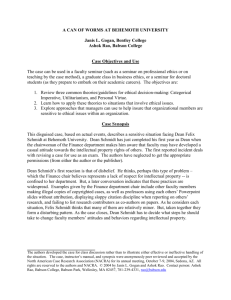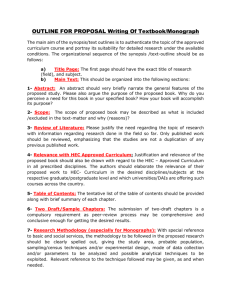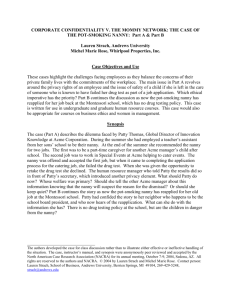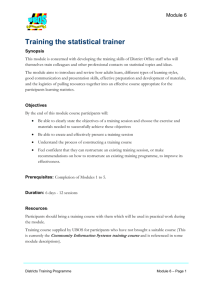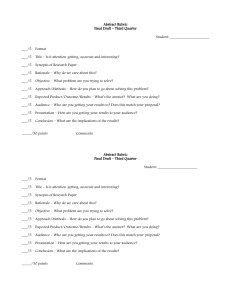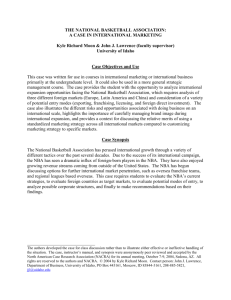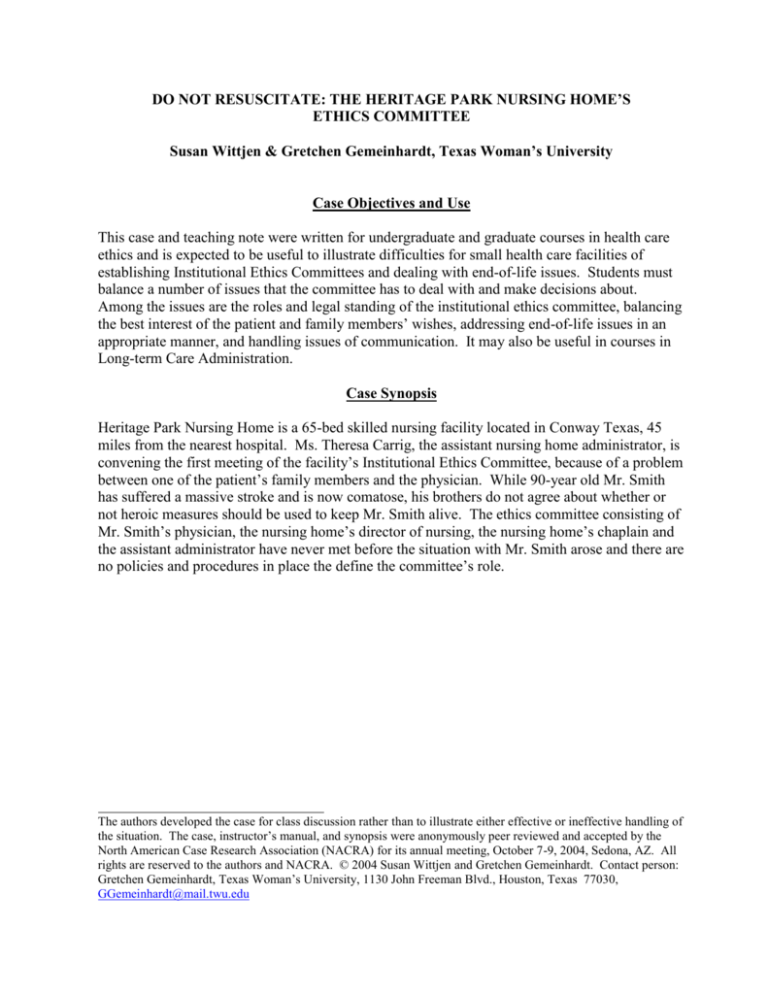
DO NOT RESUSCITATE: THE HERITAGE PARK NURSING HOME’S
ETHICS COMMITTEE
Susan Wittjen & Gretchen Gemeinhardt, Texas Woman’s University
Case Objectives and Use
This case and teaching note were written for undergraduate and graduate courses in health care
ethics and is expected to be useful to illustrate difficulties for small health care facilities of
establishing Institutional Ethics Committees and dealing with end-of-life issues. Students must
balance a number of issues that the committee has to deal with and make decisions about.
Among the issues are the roles and legal standing of the institutional ethics committee, balancing
the best interest of the patient and family members’ wishes, addressing end-of-life issues in an
appropriate manner, and handling issues of communication. It may also be useful in courses in
Long-term Care Administration.
Case Synopsis
Heritage Park Nursing Home is a 65-bed skilled nursing facility located in Conway Texas, 45
miles from the nearest hospital. Ms. Theresa Carrig, the assistant nursing home administrator, is
convening the first meeting of the facility’s Institutional Ethics Committee, because of a problem
between one of the patient’s family members and the physician. While 90-year old Mr. Smith
has suffered a massive stroke and is now comatose, his brothers do not agree about whether or
not heroic measures should be used to keep Mr. Smith alive. The ethics committee consisting of
Mr. Smith’s physician, the nursing home’s director of nursing, the nursing home’s chaplain and
the assistant administrator have never met before the situation with Mr. Smith arose and there are
no policies and procedures in place the define the committee’s role.
The authors developed the case for class discussion rather than to illustrate either effective or ineffective handling of
the situation. The case, instructor’s manual, and synopsis were anonymously peer reviewed and accepted by the
North American Case Research Association (NACRA) for its annual meeting, October 7-9, 2004, Sedona, AZ. All
rights are reserved to the authors and NACRA. © 2004 Susan Wittjen and Gretchen Gemeinhardt. Contact person:
Gretchen Gemeinhardt, Texas Woman’s University, 1130 John Freeman Blvd., Houston, Texas 77030,
GGemeinhardt@mail.twu.edu
JESSICA CASSERRA’ S TASK FORCE:
HOSPITAL INTEGRATION IN THE REGION OF ERIE
Gene Deszca, Wilfrid Laurier University
Case Objectives and Use
The case addresses integration challenges a credible and capable senior hospital manager (Jessica
Casserra) faces when economic and political pressures from the Province make change
inevitable. The services of five small local hospitals and a larger regional hospital are to be
integrated in some manner, opening the door to a discussion of strategy, structure and design.
Integration planning is to be done by a task force chaired by Jessica, but approval rests with the
independent boards of the six public hospitals. The vision of the desired end state is unclear and
varies with the perspective of the various stakeholders. Differences in the size and fiscal health
of the hospitals and potential Provincial funding implications further complicates the integration
challenge, enriching the discussion of power, politics and how Jessica should manage the
leadership and implementation challenges ahead (change management). Finally, the career
implications of being centrally involved in initiatives such as this can be discussed. The case is
designed to be an integrating case written for business school students in change management,
organizational behavior or similar courses dealing with the not-for-profit/health care sectors.
Case Synopsis
Jessica Casserra, CFO of the largest hospital in the region, has been asked to orchestrate the
integration of hospital care delivery for the region. Five of the area hospitals are small, serving
outlying towns, while the largest is located in the main metropolitan area. Jessica is credible and
competent, but the magnitude of the undertaking is new to her. Provincial funding authorities,
looking for greater financial efficiency in health care delivery, have mandated the rationalization
of services, but downloaded the ultimate responsibility to the local level. She has ten months in
which to reach agreement on a solution and there are severe financial implications related to
failure. Each hospital is public, has its own board and supporters, and there is no consensus
among the various stakeholders as to what the hospital health care delivery model should look
like or what role the various facilities should play (if any). Mistrust over agendas and loyalty to
local institutions and professions combine to make the task more complex, but there is awareness
that the current delivery system in the region is in need of improvement (e.g., problems attracting
and retaining health care professionals and specialists, questions related to access to and the
quality of specialty services and procedures, etc). The task force has already been designed and
Jessica must figure out how to work with it and the affected institutions and stakeholders during
this uncertain transitional period.
The author developed the case for class discussion rather than to illustrate either effective or ineffective handling of
the situation. The case, instructor’s manual, and synopsis were anonymously peer reviewed and accepted by the
North American Case Research Association (NACRA) for its annual meeting, October 7-9, 2004, Sedona, AZ. All
rights are reserved to the authors and NACRA. © 2004 by Gene Deszca. Contact person: Gene Deszca, School of
Business and Economics, Wilfrid Laurier University, Waterloo, Ontario, Canada, N2L 3C5, Phone: 519-884-0710,
ext. 2560, gdeszca@wlu.ca
MATRIX STEM CELLS: A NEW TECHNOLOGY IN HEALTH CARE RESEARCH
Wayne Edwards, Andrea A. Law-Carey, Brian Riedel,
Dan Walker, & Jeffrey Katz (faculty supervisor)
Kansas State University
Case Objectives and Use
This case gives students the opportunity to read and study the history of a new technology from
its beginning. Students are given the opportunity to make and justify decisions on where the
technology should be focused in the future. While the case study includes an invention based in
the biological sciences, there is adequate information to conduct an assessment of the growing
industry related to this technology and develop feasibility analysis regarding how Dr. Weiss and
his employer should proceed to commercially advance his work.
Case Synopsis
Dr. Mark Weiss, has spent much of his research effort focused on non-embryonic stem cells
derived from the umbilical cord. In 2002, his employer applied for a U.S. patent based on his
work. His invention relates to isolating, culturing, maintaining, and transforming stem cells into
useful cell types using genetic or other transformation technologies. His invention can also be
applied to stem cell and tissue banking and the use of untransformed or transformed cells in
disease treatment. This invention comes at a time when there is an aggressive debate regarding
the use of stem cells from traditional sources: embryos. The patent applied for seeks to protect
the recent stem cell discoveries, the method of culturing the stem cells, and a kit for salvaging
umbilical cord stem cells after birth. Specifically, the invention “relates to isolating the stem
cells, culturing the stem cells, and transforming the stem cells into useful cell types using genetic
or other transformation technologies, and using untransformed or transformed cells in placental
mammalian, human or animal disease treatment and related biotechnology” (Patent application
10,083,779). His invention has made it possible to obtain stem cells from non-controversial,
universally available, species-specific sources. The case describes the technology, provides
information regarding potential competitors, and provides several alternatives for students to
consider as Dr. Weiss and his employer seek to advance his invention. Alternatives for students
to consider include: Selling the patent, licensing the technology, developing a joint venture, and
independently commercializing the invention.
The authors developed the case for class discussion rather than to illustrate either effective or ineffective handling of
the situation. The case, instructor’s manual, and synopsis were anonymously peer reviewed and accepted by the
North American Case Research Association (NACRA) for its annual meeting, October 7-9, 2004, Sedona, AZ. All
rights are reserved to the authors and NACRA. © 2004 by Wayne Edwards, Andrea A. Law-Carey, Brian Riedel,
Dan Walker, and Jeffrey Katz. Contact person: Jeffrey Katz, Department of Management, Kansas State University
Manhattan, Kansas 66506, 785-532-7451, jkatz@ksu.edu
“Mr. K” –B: WHITHER THE FOUNDATION?
Marilyn L. Taylor, University of Missouri at Kansas City
John Altman, Ewing Marion Kauffman Foundation
Case Objectives and Use
This case was developed for use with Entrepreneurship, Leadership, Management of Not-forProfits, Strategic Management, and Public Administration courses. It provides opportunity to
explore the vision/mission of a Foundation on the edge of becoming one of the major
foundation entities in the United States. Among the concepts that can be applied are:
leadership (for-profit/entrepreneurial companies and not-for-profit organizations), social
entrepreneurship, vision/mission in not-for-profits, organizational growth, organizational
development, resource allocation/strategy implementation and managing personal life stages.
Case Synopsis
This case focuses on the Ewing Marion Kauffman Foundation at the time the Founder died in
August 1993. The case provides opportunity for the student to identify the issues that the
Foundation was facing. The case provides opportunity for classroom discussion and analysis or
for role-play of key figures in the Foundation.
Ewing Marion Kauffman had founded the very successful Kansas City-based firm, Marion
Laboratories, Inc. in 1950. In 1989 after more than six years of unprecedented growth in both
revenues and profit, Marion Laboratories announced the firm would merge with Merrill Dow.
The transaction yielded about $1B for Mr. Kauffman.
Mr. Kauffman had already set up a charitable remainder trust to benefit the Foundation at the
time of his death. The Foundation had four ongoing programs in “Youth Development”: Project
Star. The Foundation had also formed the Center for Entrepreneurial Leadership to which half of
the Foundation’s assets were to be dedicated. The Center had initiated its first adult training
program and was planning programs for K-12.
When Mr. Kauffman died, the Foundation’s leaders confronted the issues surrounding what to do
next. They asked, “What would Mr. Kauffman have done?”
The authors developed the case for class discussion rather than to illustrate either effective or ineffective handling of
the situation. The case, instructor’s manual, and synopsis were anonymously peer reviewed and accepted by the
North American Case Research Association (NACRA) for its annual meeting, October 7-9, 2004, Sedona, AZ. All
rights are reserved to the Ewing Marion Kauffman Foundation, authors, and NACRA. © 2004 by Marilyn L Taylor
and John Altman. Contact person: Marilyn L. Taylor, University of Missouri at Kansas City, 5110 Cherry, Kansas
City, MO 64110 816-235-5774 taylorm@umkc.edu
OHIO PRESBYTERIAN RETIREMENT SERVICES (OPRS)
Shirine L. Mafi, & Von K. Bowersock
Otterbein College
Case Objectives and Use
The case shows the difficulty in deciding how scare resources are to be allocated between
competing plans. Not-for-profit organizations in particular face a daunting challenge since they
have a mission with a multitude of stakeholders whose objectives (i.e., stewardship) are more
abstract and complex than for-profit firms. Management has to develop a plan that balances the
urge for growth in a fast-growing market (elderly population) with sustainability of a business
based on sound financial plans. Furthermore, the elderly care industry is complex, regulated and
ever changing due to changes in the environment. Managers should not only know about sound
financial and management theories but they should also know the nuances particular to service
operations (i.e., servicescape, consumer benefit package). The case is most suitable for upper
division undergraduate service operations management or graduate courses in business
administration (not-for-profit), management of services, and health administration.
Case Synopsis
OPRS was a provider of continuous care for the elderly population in Ohio. OPRS owned and
operated eleven retirement communities. Eight of these were full service retirement communities
and provided services ranging from independent living, assisted living, skilled and special
nursing care to outreach community services. Key decision issues for OPRS Board were: 1)
decisions on the proper allocation of resources to operations, renovation and expansion of OPRS
campuses and services; 2) underutilization of facilities related to occupancy rate at established
and newer campuses; and 3) OPRS’ ability to attract debt financing in support of its strategic
planning. The discussion of these issues had become more complex. Constant changes in the
environment including increases in health care regulations and costs have made the future of the
elderly care industry uncertain. Additionally the decisions of resource allocation were burdened
by the increase in demand for the elderly care services due to population aging as well as an
increase in baby boomers’ expectations of such services. The Board also considered the increase
in competition from newly developed adult communities that were more attractive to OPRS
prospective residents. To top it all the public image of continuous care facilities—especially the
negative image of nursing home and overall lack of public awareness of the services offered to
the community—made it rather difficult to persuade a larger group of potential donors and
influence regulatory agencies at the federal, state and local levels. The case is accompanied by a
20- minute CD including a tour of one of the OPRS’ campuses as well as an interview with the
President/CEO of OPRS.
The authors developed the case for class discussion rather than to illustrate either effective or ineffective handling of
the situation. The case, instructor’s manual, and synopsis were anonymously peer reviewed and accepted by the
North American Case Research Association (NACRA) for its annual meeting, October 7-9, 2004, Sedona, AZ. All
rights are reserved to the authors and NACRA. © 2004 by Shirine L. Mafi and Von K. Bowersock. Contact
person: Shirine Mafi, Department of Business, Accounting and Economics, Otterbein College, 1 Otterbein,
Westerville, Ohio 43081, 614-823-1796, smafi@otterbein.edu
QUADRA DANGLES: A SQUARE UNFILLED?
Karen Page & Troy Brin
University of Wyoming
Case Objectives and Use
The case shows a non-profit group dedicated to square dancing witnessing the slow demise of
the organization in light of changing recreational preferences and a lack of strategic focus. This
case is designed to encourage thought and discussion about how important it is for a firm, nonprofit or otherwise, to recognize negative trends and react to them promptly and appropriately
instead of waiting until a major problem exists. The case provides a vehicle for teaching SWOT
analysis, marketing approaches, and the application of corporate strategies. The case is intended
for both undergraduate and graduate students in marketing, strategy and policy courses, and
courses in non-profit management, as well as other applicable courses in a business curriculum.
Case Synopsis
The Quadra Dangles Square Dance Club in Laramie, Wyoming, has seen its membership decline
steadily over the years from a high of well over 200 members in the 1950s and 1960s. In the
past, attempts by the club to recruit new members have been modest at best despite the declining
membership, because the membership levels were still high enough to provide a sufficient
turnout at its dances. Today, the club has only 54 active members, with an average of 25
attending any given dance held by the organization. This has the organization’s board
wondering what additional steps can be taken to increase membership before there aren’t enough
members to hold dances with.
The authors developed the case for class discussion rather than to illustrate either effective or ineffective handling of
the situation. The case, instructor’s manual, and synopsis were anonymously peer reviewed and accepted by the
North American Case Research Association (NACRA) for its annual meeting, October 7-9, 2004, Sedona, AZ. All
rights are reserved to the authors and NACRA. © 2004 by Karen Page and Troy Brin. Contact person: Karen Page
College of Business, Department of Management and Marketing, University of Wyoming, P.O. Box 3275 Room
228, Laramie, Wyoming 82071, 307-766-3124, klpage@uwyo.edu
SCHOLARSHIPS FOR HOPI CHILDREN:
THE DAVID VERSUS GOLIATH BATTLE IN THE AMERICAN SOUTHWEST
Lawrence C. Mohrweis & Casey L. Donoho
Northern Arizona University
Case Objectives and Use
The primary objective of this case is to enhance students’ understanding of the components that
are critical to developing a successful direct marketing plan for a not-for-profit organization.
The case was written for business school undergraduate courses focusing on marketing
management, marketing strategy, and not-for-profit marketing.
As a case in a marketing course, the case does a particularly good job at illustrating: (1) the
importance of buyer behavior in all marketing plans and actions, (2) the importance of target
marketing based upon a distinct position and message in the marketplace, (3) a “hands-on
approach” using the internet and direct-mail web-sites to illustrate the approaches to target
audiences using direct marketing techniques, (4) the appropriateness of marketing in all types of
organizations, including not-for-profit ones which seek to “do good” , and (5) the problems
involved in forecasting the impact of marketing and the return on investment of marketing
expenditures.
Case Synopsis
This case begins by describing a small mission school on an Indian Reservation. The 50 year old
school is struggling financially to remain in existence. Over time, the traditional support from its
sponsoring church bodies has decreased. Thus, the school has had to find alternative sources of
income, the most promising of which is a new state tax credit program allowing married
taxpayers to assign up to $625 of their State tax due to a private school of their choice.
However, the taxpayer must write out a check before the end of the calendar year and he or she
receives the tax credit later upon filing a State return. The president of the scholarship fund
supporting the school is considering a direct marketing approach to solicit these tax credit
donations.
The case write-up presents a scenario requiring students to analyze the viability of different
direct marketing strategies. The case provides a platform for assessing the challenges and
problems facing not-for-profit organizations. The case requires students to analyze the current
situation for the school, develop a position and message, and complete a marketing plan to solicit
these tax credit donations within the funding constraints.
The authors developed the case for class discussion rather than to illustrate either effective or ineffective handling of
the situation. The case, instructor’s manual, and synopsis were anonymously peer reviewed and accepted by the
North American Case Research Association (NACRA) for its annual meeting, October 7-9, 2004, Sedona, AZ. All
rights are reserved to the authors and NACRA. © 2004 by Lawrence C. Mohrweis and Casey L. Donoho. Contact
person: Lawrence C. Mohrweis, College of Business Administration, Box 15066, Northern Arizona University,
Flagstaff, AZ 86011-5066, 928-523-9580, lawrence.mohrweis@nau.edu



